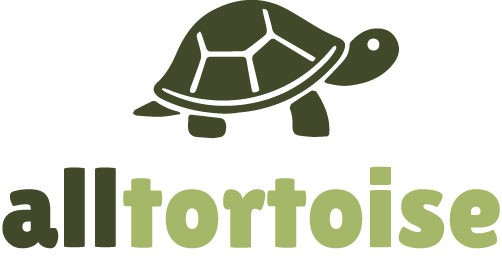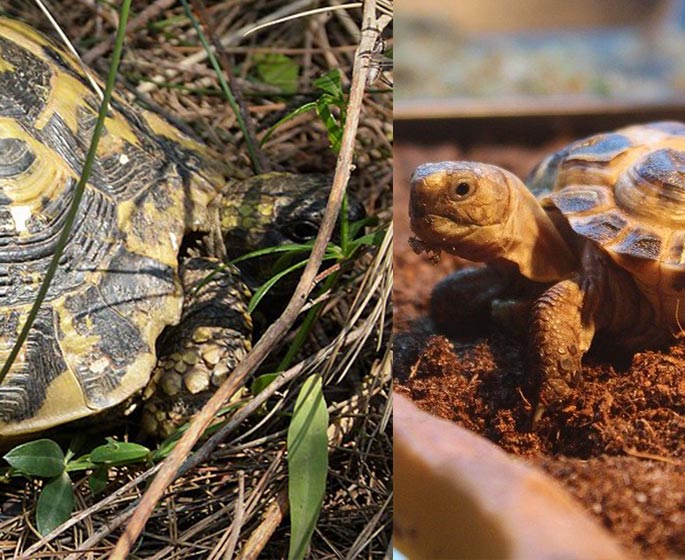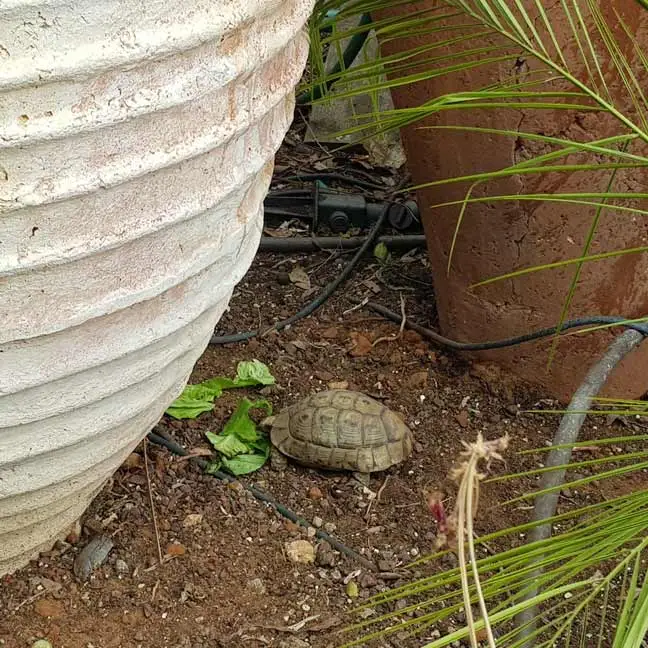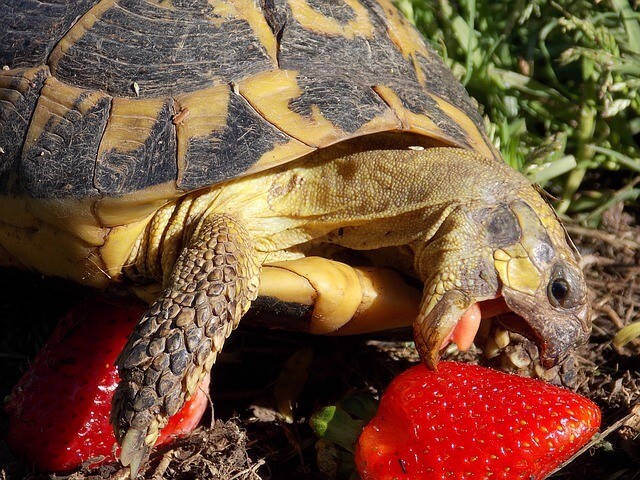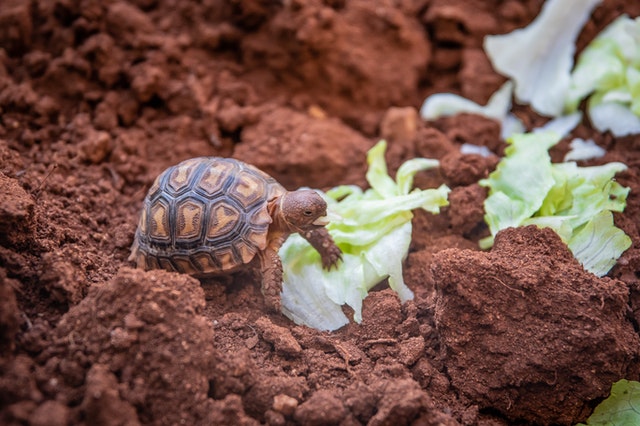Are you torn between Hermann’s tortoise and Russian tortoise? Do you want to know the difference between the two tortoises? Then, this guide is for you.
Knowing and understanding the difference between Hermann’s and Russian tortoises helps make the best decision when choosing a long-term reptile pet. Most people end up choosing between these two tortoises because of their smaller size. These two reptiles also have a reputation for being suitable for beginners.
When caring for pets like tortoises, it is critical to find a species that best suits the time and space you can devote to their care. The good news is that both the Hermann’s and Russian tortoises are small creatures that only require a few feet of your living space.
If you are still undecided between Hermann’s and Russian tortoises, here’s a quick overview of the two in a comparison table:
| Russian Tortoise | Hermann’s Tortoise | |
Common Names | Central Asian tortoise, Horsfield tortoise, steppe tortoise, and Afghan tortoise | Hermann’s |
| Class | Reptilia | Reptilia |
| Scientific Name | Agrionemys Horsfieldii | Testudo Hermanni |
| Suborder | Cryptodira | Cryptodira |
| Order | Testudines | Testudines |
| Species | A. Horsfieldii | T. Hermanni |
| Genus | Agrionemys | Testudo |
| Family | Testudinidae | Testudinidae |
| Origin | Western China, Pakistan, Iran, and Russia | Balkan General and Mediterranean Europe |
| Size | 5 to 8 in (12 to 20 cm) | 5 to 8 in (13 to 20 cm) |
| Enclosure Size | 4 ft x 2 ft x 12-14 ft | 3.7 ft |
| Weight | 1 to 3 lb (0.5 to 1.5 kg) | 7 to 9 lb (3 to 4 kg) |
| Lifespan | 40 years | 50 years |
| Lighting | Heating and UV when indoors | Heating and UV when indoors |
Heating | Daytime: 60°F to 85°F (15°C to 30°C)Basking Spot: 60°F to 85°F (15°C to 30°C)Nighttime 40°F to 75°F (5°C to 25°C | Daytime: 60°F to 85°F (15°C to 30°C)Basking Spot: 60°F to 85°F (15°C to 30°C)Nighttime 40°F to 75°F (5°C to 25°C) |
| Humidity | 40% to 75% | 40% to 75% |
Hibernation | Hibernates up to 9 months or 8 weeks in captivity; should be at least five inches long before hibernation | Hibernates during winter; put them in a domestic fridge for a safe temperature |
| Diet | Strict herbivore | Strict herbivore |
Personality | Some are outgoing while others are shy; they should be handled with care and gentleness | Very outgoing and like to interact with others; should be handled with care and gentleness |
Now that you already have a few ideas about the differences or similarities between Hermann’s and Russian tortoises, let’s dive into a more detailed comparison.
Size and Weight
Both of these two tortoises are small reptiles, making them an ideal choice for those who have limited space for pets. Because of their smaller size, smaller enclosures are enough for them.
Hermann’s Tortoise
An adult Hermann tortoise generally ranges from 5 to 8 in (13 to 20 cm). They weigh between 7 to 9 lbs (3 to 4 kg. on average, females are 12 percent larger than males. If they are three years old or younger, it is difficult to disguise male and female Hermann’s tortoises.
Russian Tortoise
An adult Russian tortoise ranges from 5 to 8 in (12 to 20 cm) and weighs between 1 to 3 lbs (0.5 to 1.5 kg). Generally, females are a bit larger than males. However, they are not as big as Hermann’s male and female tortoises.
Lifespan
People who want to make tortoises as their pets should realize that they are a serious commitment. The two tortoise species have a longer lifespan than other pets like dogs.
Hermann’s Tortoise
A Hermann’s tortoise can live up to 50 years in the wild but cut to 25 to 30 years because of predators.
Russian Tortoise
A Russian tortoise has 50 years lifespan, and over 50 years is an unusual lifespan.
Living Environment and Enclosure Size
A Hermann tortoise is better when it comes to dealing with ever-changing weather conditions. If you live in a colder and wetter area, they are the right choice.
Hermann’s Tortoise
A Hermann’s tortoise is kept outside when the weather allows. While they are sturdy, they still need a spot that drains effectively. They require an enclosure to overcome harsh weather conditions. An indoor enclose must be large enough to let them roam freely. Ideally, the size is around 3.7 ft in span.
Russian Tortoise
A Russian tortoise must have an outside living, but this species is not as hardy as other species like Hermann tortoises. They need a secure border since they are great burrowers. They can even dig out of the yard with ease. So, burying the chicken wire is helpful to prevent them from escaping. You should provide them with a 4 ft x 2 ft x 12 to 14 indoor enclosure.
Heating and Lighting Requirements
Hermann’s and the Russian tortoise are a little different when it comes to heating and lighting requirements.
Hermann’s Tortoise
A Hermann’s tortoise requires UV lighting if you keep it indoors. The daytime temperatures must be between 60°F to 85°F (15°C to 30°C), while the basking spot must be around 60°F to 85°F (15°C to 30°C). The nighttime temperature should no drop between 40°F to 75°F (5°C to 25°C).
Russian Tortoise
A Russian tortoise needs a UV light supply when kept inside. Daytime temperatures should be between 60°F to 85°F (15°C to 30°C), while the basking spot has to be between 60°F to 85°F (15°C to 30°C). Temperatures at night should range from 40°F to 75°F (5°C to 25°C).
Substrate Requirements
A Russian tortoise may require a substrate letting it burrow, but the choices are limited. Meanwhile, Hermann’s tortoise is easier to cater to its substrate requirements with a lot of options.
Hermann’s Tortoise
A Herman tortoise is quite fussed when it comes to substrate requirements. The recommended substrates include straw, reptile bark, pulverized coconut, shredded aspen, and cypress mulch.
Russian Tortoise
As mentioned above, a Russian tortoise needs a substrate to let them button. You can prepare soil alongside sand mix to allow them to burrow and hide.
Diet
Hermann’s and Russian tortoises have the same diet. The only difference is that Russian tortoises prefer eating more fruits.
Hermann’s Tortoise
A Hermann’s tortoise is 90 percent herbivorous. In the wild, they occasionally eat invertebrates. However, it is advisable to feed them a strict herbivore diet in captivity. Plus, a mix of green vegetation is easy to offer. You can give them kale, collard green, mustard greens, and mustard tops.
Russian Tortoise
A Russian tortoise eats succulent vegetation, such as flowers, twigs, grasses, and a little fruit. Beware that they do not eat invertebrates even in the wild.
Social Structure
Do you plan to take care of multiple tortoises at home? If yes, Hermann’s tortoises are a perfect choice.
Hermann’s Tortoise
A Hermann’s tortoise can live happily alone. You do not need to give them companions. Never mix those with a large size difference. Keeping makes together will only make them fight. On the other hand, females are happy living together. You can mix one male with different female Hermann’s females.
Russian Tortoise
A Russian tortoise is known to be extraordinarily territorial. In most cases, they do not mix well with other tortoise species. Additionally, keep Russian tortoises from similar species because of their aggression.
Hibernation
Just like other reptiles, Hermann’s and Russian tortoises also undergo hibernation. So, you need to know their hibernation needs to help them hibernate safely and successfully.
Hermann’s Tortoise
A Hermann’s tortoise requires to hibernate during the winter season. You can help them hibernate by placing them in a domestic fridge. By doing so, you can provide them with safe temperatures and prevent exposure to harsh winter climates. Remember that the winter months can have varying temperatures day by day.
Russian Tortoise
Russian tortoises hibernate for up to 9 months per year in the wild. Meanwhile, they can hibernate for as little as eight weeks in captivity. They must be at least 5 in long before the hibernation period.
Personality and Characteristics
Before getting a specific tortoise species, it is an excellent idea to know their personality and characteristics. That way, you know how to deal with them.
Hermann’s Tortoise
A Hermann’s tortoise is very outgoing and enjoys going out. They are happy to interact with others. Lifting them off the ground for too long at can time can frighten them. So, ensure to handle them with care. You can help thrive by providing them sunlight and fresh air every day.
Russian Tortoise
Unlike Hermann’s tortoise, the Russian tortoise’s personality varies greatly. You may encounter some that are ongoing, while others are shy. You should also handle them with care and gentleness.
Final Thoughts
Whichever type of tortoise you choose, they will undoubtedly bring you many years of fun moments and companionships. Once you take care of them properly, they will return the favor. They may have some similarities, but it is not good to keep the two species together. So, it is best to choose the one that suits best your capacity to care for a tortoise and your preference. Taking care of them may be a big commitment, but the happiness and companionship they provide are incomparable.
